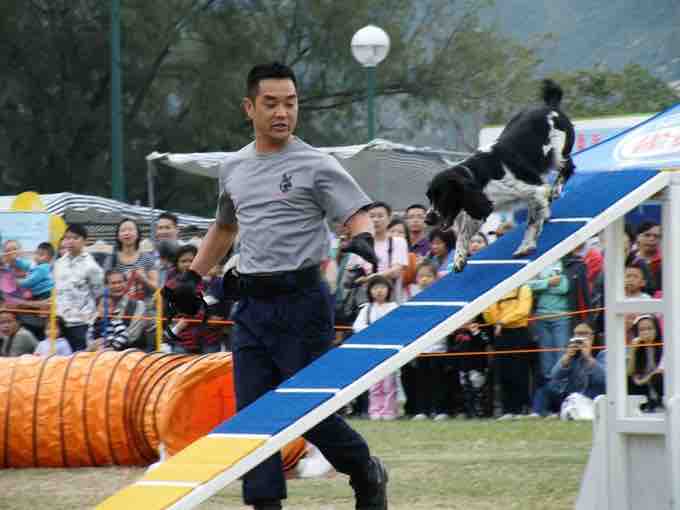In his operant-conditioning experiments, Skinner often used an approach called shaping. Instead of rewarding only the target, or desired, behavior, the process of shaping involves the reinforcement of successive approximations of the target behavior. The method requires that the subject perform behaviors that at first merely resemble the target behavior; through reinforcement, these behaviors are gradually changed, or shaped, to encourage the performance of the target behavior itself. Shaping is useful because it is often unlikely that an organism will display anything but the simplest of behaviors spontaneously. It is a very useful tool for training animals, such as dogs, to perform difficult tasks.

Dog show
Dog training often uses the shaping method of operant conditioning.
How Shaping Works
In shaping, behaviors are broken down into many small, achievable steps. To test this method, B. F. Skinner performed shaping experiments on rats, which he placed in an apparatus (known as a Skinner box) that monitored their behaviors. The target behavior for the rat was to press a lever that would release food. Initially, rewards are given for even crude approximations of the target behavior—in other words, even taking a step in the right direction. Then, the trainer rewards a behavior that is one step closer, or one successive approximation nearer, to the target behavior. For example, Skinner would reward the rat for taking a step toward the lever, for standing on its hind legs, and for touching the lever—all of which were successive approximations toward the target behavior of pressing the lever.
As the subject moves through each behavior trial, rewards for old, less approximate behaviors are discontinued in order to encourage progress toward the desired behavior. For example, once the rat had touched the lever, Skinner might stop rewarding it for simply taking a step toward the lever. In Skinner's experiment, each reward led the rat closer to the target behavior, finally culminating in the rat pressing the lever and receiving food. In this way, shaping uses operant-conditioning principles to train a subject by rewarding proper behavior and discouraging improper behavior.
In summary, the process of shaping includes the following steps:
- Reinforce any response that resembles the target behavior.
- Then reinforce the response that more closely resembles the target behavior. You will no longer reinforce the previously reinforced response.
- Next, begin to reinforce the response that even more closely resembles the target behavior. Continue to reinforce closer and closer approximations of the target behavior.
- Finally, only reinforce the target behavior.
Applications of Shaping
This process has been replicated with other animals—including humans—and is now common practice in many training and teaching methods. It is commonly used to train dogs to follow verbal commands or become house-broken: while puppies can rarely perform the target behavior automatically, they can be shaped toward this behavior by successively rewarding behaviors that come close.
Shaping is also a useful technique in human learning. For example, if a father wants his daughter to learn to clean her room, he can use shaping to help her master steps toward the goal. First, she cleans up one toy and is rewarded. Second, she cleans up five toys; then chooses whether to pick up ten toys or put her books and clothes away; then cleans up everything except two toys. Through a series of rewards, she finally learns to clean her entire room.